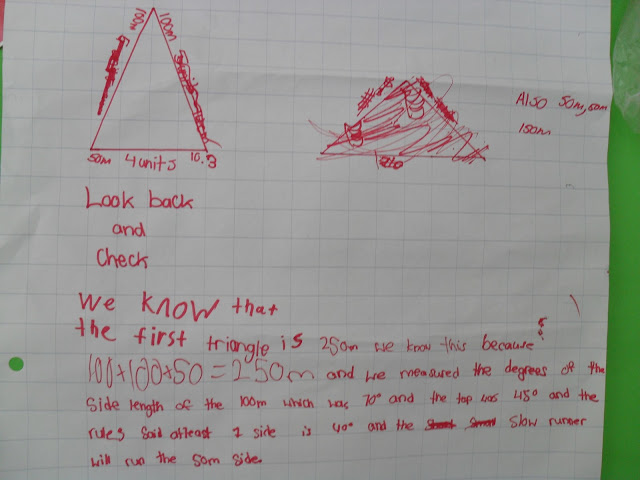Materials from the co-teaching session can be found through these links:
Three-Part lesson plan
KWC Chart
Assessment for Learning template
Prior to the lesson:
Students in Shari's class just began their Geometry unit. They had one lesson around the properties of triangles. This was the second lesson in their unit so it's more a diagnostic task.
The class had a lot of prior experiences with the problem solving process and the KWC chart:
 |
| The KWC chart and how it fits into the problem solving process. |
 |
| The steps in the problem solving process. |
 |
| Success criteria for the problem solving and communicating process. |
Part 1: Activation of Prior Knowledge
- the difference between a rectangular and square relay course
- what a triangular course might look like
After students demonstrated what a relay course might look like, Paula asked students to share what they knew about triangles. She recorded their ideas on chart paper so they could refer to it while solving the problem, which they did!
Part 2: Working on It
Shari introduced the problem to the class.
After the class read over the problem together, she recorded their ideas on the KWC chart.
When this was done, she asked: What do you need to do to be successful in this task?
She recorded their ideas on chart paper, with little editing.
Part 3: Reflecting and Connecting
Many groups struggled with this problem. Shari saw this as a positive since it illuminated a lot of student misconceptions, which she can address during the unit.
The groups that were chosen to share their work during the math congress all brought out a key point Shari wanted to make to the group.
 |
| This group had an accurate solution. However, they began with the side lengths as well. They could not articulate the process they went through to make sure the angles were correct as well. |
 |
| This group's work was incomplete but contributed to the big idea that constructing the angles of the triangle first, then the side length is a preferred process. |
Teacher Reflection
 |
| The entire class demonstrated perseverance throughout this problem. This was something Shari appreciated about her class and she referred to this during her debriefing with the group. |






I just discovered your blog and very much appreciate the clarity with which you have debriefed the 3 parts of the lesson. Your reflections make the focus of each part very clear, and the photos of student work and anchor charts help us see them "in action". Thank you so much for sharing with the rest of us.
ReplyDeleteWould you be able to tell me where you got your mini-posters of the problem solving strategies? There are many posters out there that list them but I like how yours have a description underneath. Thanks!
ReplyDeleteThank You and I have a keen supply: How Many Houses Has Hometown Renovated home renovation on a budget
ReplyDeletehermes birkin outlet
ReplyDeletegolden goose outlet storet
fear of god outlet
pg 4
birkin bag
hermes outlet
off white hoodie outlet
kyrie shoes
palm angels
cheap curry shoes